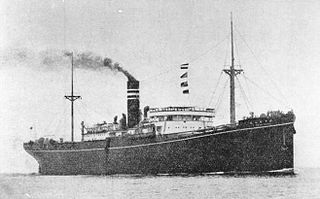
Lisbon Maru (りすぼん丸) was a Japanese cargo liner built at Yokohama in 1920 for a Japanese shipping line. During World War II the ship became an armed troopship. On her final voyage Lisbon Maru was also transporting prisoners-of-war between Hong Kong and Japan when torpedoed on 1 October 1942, sinking with a loss of over 800 lives.

Nippon Yusen is one of the oldest and largest shipping companies in the world. It is a member of the Mitsubishi keiretsu. The company has its headquarters in Chiyoda, Tokyo, Japan and a fleet of about 800 ships, that includes container ships, tankers, bulk and woodchip carriers, Ro-Ro car carriers, reefer vessels, LNG carrier and cruise ships.

MS Aramis was built for France's Messageries Maritimes for the France-Southeast Asia colonial route. One of her distinguishing features was that her funnels were square-shaped. She was built to carry 1,045 civilian passengers in first, second, third, and steerage class. She was converted to an armed merchant cruiser when France entered World War II, until demilitarized following the Second Armistice at Compiègne on 22 June 1940. Aramis was seized by Japan in 1942, renamed Teia Maru (帝亜丸), and served as a repatriation ship in 1943. She served as a transport between Singapore and Japan in 1944 until sunk in the battle for convoy Hi-71 while assigned to the defense of the Philippines.

Hikawa Maru (氷川丸) is a Japanese ocean liner that Yokohama Dock Company built for Nippon Yūsen Kabushiki Kaisha. She was launched on 30 September 1929 and made her maiden voyage from Kobe to Seattle on 13 May 1930. She is permanently berthed as a museum ship at Yamashita Park, Naka-ku, Yokohama.

Asama Maru was a Japanese ocean liner owned by Nippon Yusen Kaisha (NYK). The ship was built in 1927–1929 by Mitsubishi Shipbuilding & Engineering Co. at Nagasaki, Japan. The vessel was named after an important Shinto shrine.

The Hōkoku Maru-class ocean liner was a class of ocean liners of Japan, serving during 1940 and World War II.

Tatsuta Maru (龍田丸), was a Japanese ocean liner owned by Nippon Yusen Kaisha (NYK). The ship was built in 1927–1929 by Mitsubishi Shipbuilding & Engineering Co. at Nagasaki, Japan. The vessel was named after Tatsuta Jinja an important Shinto shrine in Nara Prefecture.

The Kamikawa Maru-class cargo ship was a type of cargo ship of Japan, serving during the 1930s and World War II. Four of the five ships of the class were converted to seaplane tenders during the war.
The Yokohama Maru was a 6143 gross ton passenger and cargo vessel built by Mitsubishi Dockyard & Engine Works, Nagaski for Nippon Yusen Kabushiki Kaisha and launched in 1912. The ship was used on the Guam to Japan route. She was requisitioned by the Imperial Japanese Army and fitted out as a troop transport.

The Terukuni Maru-class ocean liner was a class of ocean liners of Japan, serving during the 1930s, and into World War II.

The Chichibu Maru (秩父丸) was a Japanese passenger ship which, renamed Kamakura Maru, was sunk during World World II, killing 2,035 soldiers and civilians on board.
The China Maru was a 5,870 gross ton cargo ship built by Kawasaki Dockyard Company, Kobe, for Kawasaki Kisen Kabushiki Kaisha in 1920. The cargo ship ran aground off Balum Island, Feni Islands, Papua New Guinea, on 26 June 1939, while steaming to Sydney from Yokohama, and was later refloated. She was requisitioned in 1941 by the Imperial Japanese Navy for use during World War II. On 10 March 1942, during the invasion of Lae-Salamaua, China Maru was damaged by SBD aircraft from the United States Navy aircraft carriers USS Lexington and USS Yorktown off Lae, New Guinea.

The steam ship Cap Finisterre was a German transatlantic ocean liner of the early 20th century, which was transferred to Japan in 1920 as German war reparations, and renamed Taiyō Maru (大洋丸) on trans-Pacific routes. She was sunk on army service by an American submarine in 1942, during World War II, with the loss of over 800 lives, mostly civilians.

Taimei Maru was a 2,883 ton transport ship of the Imperial Japanese Army during World War II.
W-26 was a W-19-class minesweeper operated by the Imperial Japanese Navy during World War II.

Heian Maru (平安丸) was a Japanese ocean liner launched in 1930 and operated primarily on the NYK line's trans-Pacific service between Yokohama and Seattle. Shortly before the outbreak of the Pacific War, it was requisitioned by the Imperial Japanese Navy and converted to use as an auxiliary submarine tender. In 1944 it was sunk by American aircraft at Chuuk Lagoon during Operation Hailstorm. Its submerged hulk – the largest of Chuuk's "Ghost Fleet" – remains a popular scuba diving destination.

Nippon Maru (日本丸) is a Japanese museum ship and former training vessel. She is permanently docked in Yokohama harbor, in Nippon Maru Memorial Park.
Noshiro Maru was a Nippon Yusen Kaisen (NYK) Liner completed in 1934 and requisitioned by the Imperial Japanese Army (IJA) in 1937 to transport troops to China following the Marco Polo Bridge Incident. She was later returned to civilian service before being converted to an armed merchant cruiser by the Imperial Japanese Navy (IJN) in 1941. She was bombed twice and torpedoed twice as a World War II troopship before being abandoned at Manila in 1944.

Meiji Maru (明治丸) is a Japanese sailing ship that serves as a museum ship in Tokyo. It is displayed at the Etchujima Campus of the Tokyo University of Marine Science and Technology.
Gokoku Maru (護國丸) was an armed merchant cruiser of the Imperial Japanese Navy in World War II, the last ship of the Hōkoku Maru class ocean liners. The ship entered service in 1942, and was employed mainly as a troop transport. She came under attack several times during her service career, and was sunk in a submarine attack in November 1944.


















